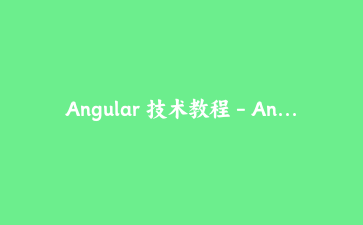Angular 技术教程 – Angular Material 组件集成详解
简介
Angular Material 提供了一组现代化的、响应式的 UI 组件,能够帮助开发者快速构建美观和功能强大的 Web 应用程序。本文将详细介绍如何在 Angular 项目中集成和使用 Angular Material 组件,并通过一个详细的案例来讲解。
环境准备
- 确保你已经安装了 Angular CLI。如果没有,可以通过运行 `npm install -g @angular/cli` 进行安装。
- 创建一个新的 Angular 项目,或者在现有项目中添加 Angular Material。这里假设你已经有一个 Angular 项目。
安装 Angular Material
首先,使用 Angular Schematics 工具来添加 Angular Material 到你的项目中。打开终端,进入你的项目目录,运行以下命令:
ng add @angular/material这将引导你进行一些配置,如选择主题、设置字体图标等。
集成 Angular Material 组件
现在你可以选择并集成 Angular Material 提供的各种组件。本文将重点讲解如何通过按钮(Button)、卡片(Card)和对话框(Dialog)这三个组件来构建一个简单的 UI。
步骤一:导入模块
首先,需要在你的 Angular 模块中导入所需的 Material 模块。打开 `app.module.ts` 文件,添加以下导入语句:
import { MatButtonModule } from '@angular/material/button';
import { MatCardModule } from '@angular/material/card';
import { MatDialogModule } from '@angular/material/dialog';
import { BrowserAnimationsModule } from '@angular/platform-browser/animations';
@NgModule({
// 其他模块配置...
imports: [
// 其他模块...
BrowserAnimationsModule, // 动画模块
MatButtonModule,
MatCardModule,
MatDialogModule,
],
// 其他配置...
})步骤二:使用组件
接下来,在你的组件模板中使用这些材料组件。
按钮(Button)
在 `app.component.html` 中添加一个按钮:
<button mat-raised-button color="primary">点击我</button></code>卡片(Card)
在按钮下方添加一个卡片:
<mat-card>
<mat-card-title>卡片标题</mat-card-title>
<mat-card-content>
<p>这是卡片的内容。</p>
</mat-card-content>
<mat-card-actions>
<button mat-button>操作1</button>
<button mat-button>操作2</button>
</mat-card-actions>
</mat-card></code>对话框(Dialog)
编写一个对话框组件,并在按钮点击时显示它。首先需要创建一个对话框组件:
ng generate component dialog-content在 `dialog-content.component.html` 中添加内容:
<p>这是一个对话框内容!</p></code>然后在 `app.component.ts` 中配置对话框:
import { MatDialog, MAT_DIALOG_DATA } from '@angular/material/dialog';
import { Component, Inject } from '@angular/core';
@Component({
selector: 'app-root',
templateUrl: './app.component.html',
styleUrls: ['./app.component.css']
})
export class AppComponent {
constructor(public dialog: MatDialog) {}
openDialog(): void {
const dialogRef = this.dialog.open(DialogContentComponent, {
width: '250px',
});
dialogRef.afterClosed().subscribe(result => {
console.log('The dialog was closed');
});
}
}
@Component({
selector: 'app-dialog-content',
templateUrl: './dialog-content.component.html',
})
export class DialogContentComponent {}
最后,在 `app.component.html` 中将按钮的点击事件与 `openDialog` 方法绑定:
<button mat-raised-button color="primary" (click)="openDialog()">打开对话框</button></code>结论
通过本文,你已经学会了如何在 Angular 项目中集成和使用 Angular Material 组件。这些组件不仅美观,而且易于使用,可以大大提高你的开发效率。你可以根据项目的需要继续探索和使用更多的 Material 组件。













